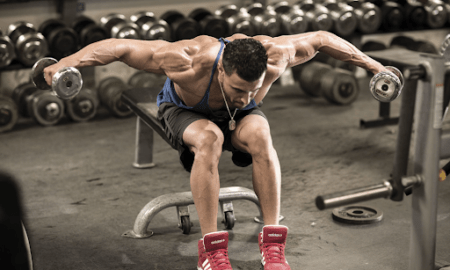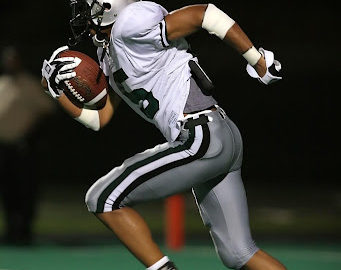
Nearly every coach and athlete knows the value of strength in sports that involve a great deal of contact: football, lacrosse, basketball, rugby, hockey, soccer and wrestling.
They also understand that achieving a higher level of strength helps anyone excel in high-skill sports that do not entail contact, such as tennis, fencing, volleyball, swimming and field events. Few, however, realize just how important the strength variable is in sports that rely primarily on endurance, such as the marathon and other long-distance running events, crew, distance skating, cross-country skiing, triathlons and other sports that require a tremendous amount of mental and physical stamina.
Endurance strength is considered by many who engage in such activities to be quite different from the type of strength needed by those who participate in sports that require only short bursts of effort followed by brief periods of rest. Those who take part in endurance sports often shun any form of heavy weight training in favor of using very light poundages, if any at all. They feel that in order to improve their endurance, they must spend more time practicing their chosen sports for longer periods of time. More than a few endurance athletes believe that lifting heavy weights is actually counterproductive because it builds larger muscles and adds unwanted bodyweight. The extra weight will slow them down, not make them faster.
That’s a misconception. It’s not necessary to add bodyweight even when heavy poundages, relatively speaking, are used in a strength program. It’s been demonstrated numerous times that a well-designed, properly executed strength routine will have a very positive influence on the performance of endurance athletes, even when they use demanding resistance.
Why? I’ll let Professor Gene Logan of Southwestern Missouri State and noted authority in the field of physiology answer that question. In his book Adaptations of Muscular Activity, he states, “Strength undergirds all other factors when one considers the total functioning of body movements. Without sufficient strength, factors such as endurance, flexibility and skill cannot be used effectively.”
It only makes sense. Before a toddler can walk, he must have enough bodily strength to support himself. After hip or knee surgery, a patient has to spend time regaining lower-body strength before becoming ambulatory. Wanting to run, swim, row or bike longer is merely an extension of the same idea. Getting strong is the key.
Of course I’m well aware that a great many other factors are involved in any athletic endeavor, but creating a rock-solid foundation of strength is critical to improving all those other attributes.
No one can deny that the amount of time athletes spend practicing the skills they need in their sport is a huge factor in their success. Stronger athletes are not only going to be able to practice longer than their weaker counterparts, but they’re also going to be able to use better technique at the end of their session. In contrast, weaker athletes’ form will falter when their strength wanes. When that happens, bad habits are formed. The well-known adage that practice makes perfect is valid only if the skills being practiced are performed correctly. Practicing sloppy technique is detrimental to progress.
For example, rowers who can produce the perfect stroke at the very end of a grueling race are going to emerge victorious over opponents who are struggling with form. A distance runner who can maintain perfect body mechanics coming down the stretch has a very definite advantage.
Someone who increases strength by 40 to 50 percent while retaining a high degree of flexibility, balance and technique in any sport is going to be a better athlete. It’s so basic, it’s often ignored. Coaches and athletes are constantly seeking a more complicated solution to a simple problem. They insert all sorts of gimmicks to improve strength in an innovative manner, then throw in yet more gimmicks to enhance foot speed, leaping ability, lateral movement and on and on. A great deal of time and energy are spent during those prolonged workouts-way too much, in fact. When energy is spread too thin, little is achieved. They trade an abundance of quantity and variety for a severe lack of quality.
My approach to helping any athlete, including the ones engaged in any type of endurance sport, is twofold: Get stronger and practice the skills needed in that sport diligently, So instead of having a rowing crew spend hours doing countless drills, I have them strength-train, and then I get them out on the water. What every athlete is seeking is a better performance, and that can be achieved through basic hard work.
I would imagine that everyone associated with the sport of Olympic weightlifting is familiar with the achievements of Norbert Schemansky. He won four Olympic medals, more than anyone in that sport, plus three world titles and nine national championships, and he set more than 50 world and Olympic records. His last world record, a 363 split snatch, was set when he was 43 years of age. When a young lifter asked him how to improve his press, Ski replied, “Do more presses.” “How about my snatch?” the lifter said. “Do more snatches,” was Ski’s answer.
Yet that approach is beyond the comprehension of many coaches and athletes. It’s just not complicated enough.
There are really two categories of athletes to deal with in regard to endurance: 1) athletes who participate in events that are long in duration and that don’t include rest periods and 2) those who participate in sports that require brief but explosive actions. This time I’ll focus on athletes in the first category, and next time I’ll deal with the second. I realize that triathletes do get short reprieves while transferring from one activity to the other, but certainly they fit into the first category.
All sports have an off-season, even if it’s only for a few months, and that’s when you need to insert a pure strength program into the yearly training schedule. The objective of the strength routine is to make all the major muscle groups stronger, with special emphasis on muscles that play a prominent role in the performance of a particular sport. For example, rowers should give more attention to strengthening their backs and shoulders than distance runners.
For the most part, however, all areas of the body should receive equal attention because having balanced strength from top to bottom is beneficial to any athlete, regardless of sport.
The program should be condensed, not long and drawn out-the mistake many endurance athletes make. Because their sport entails constant movement for an extended period of time, they figure their strength-training routine should as well. Just the opposite. The weight work should consist of only three primary and no more than two auxiliary exercises. One core movement for each of the three major muscle groups-shoulder girdle, back and hips and legs-can be followed by two auxiliary exercises for the smaller groups. Three workouts a week are sufficient. That will enable athletes to recover from the new form of stress and give them time to practice the skills of their sport.
Because the pure strength program is going to last for only six to eight weeks, the same exercises can be done at every workout. Most, however, prefer some variety in their weekly workouts. In that case, here’s what I recommend: For the shoulder girdle, or upper body, alternate flat-bench presses, inclines and overhead presses. For the back do power cleans, good mornings and either bent-over rows or deadlifts. You can do back squats three times a week using the heavy, light and medium system or do lunges on the light day.
You should select the two auxiliary exercises with the intent of improving weaker muscles. If no areas stand out as being considerably weaker, use the auxiliary exercises to enhance groups that are very much involved in the sport, For instance, a rower needs an extra strong middle back and would benefit from doing dumbbell rows while lying on a flat bench, along with lat pulls on a machine and chins. As every endurance sport relies on strong lower legs, it makes sense to do calf raises several times a week.
For the primary exercises use the tried-and-true strength formula for sets and reps: five sets of five. Do the auxiliary movements for higher reps, 20s for a couple of sets. The exception is calf raises. In order to stimulate those weight-bearing muscles, you have work them very hard-three sets of 30. If possible, do both seated and standing calf raises. The standing version hits the larger gastrocnemius, and the seated version the smaller soleus. If the two groups that form the calf are going have any impact on speed, endurance or jumping ability, they must have proportionately equal strength.
I mentioned that you can do the same three primary exercises at every workout, and many athletes like that idea. It’s easier for them to learn proper form on three movements rather than eight or nine. The three I recommend are incline presses, power cleans and back squats. I like inclines over flat benches because the inclines emphasizes the deltoids and triceps, while the flat benches involves the pecs much more. All athletes use their deltoids and triceps. They don’t all use their pecs. Some have trouble with technique on the power clean. If that’s the case, try deadlifting instead. If your sport requires a high degree of athleticism, however, stay with power cleans. They will actually enhance such valuable attributes as timing, coordination, balance and quickness.
In the beginning the primary task is to learn correct technique on all the chosen exercises, That takes precedence over everything, including numbers. With that in mind, move through the workout with purpose. Don’t lollygag between sets, but don’t rush either. Concentrate on doing every rep as precisely as possible and every set better than the last. Once your form is at least good, perhaps perfect, and the initial soreness has dissipated, pick up the pace. Especially on the lighter warmup sets, move from set to set with little rest in between. On your light days set up a circuit and move through the routine as quickly as possible.
A great many critics believe athletes cannot improve their cardiovascular-respiratory fitness in the weight room. I totally disagree, and I’ve watched it happen on many occasions. Doing a fast circuit will run your pulse rate way up, and if you stay in motion, it will remain there throughout the workout. To me it’s an added bonus for any endurance athlete. To be able to gain greater body strength and do a bit of cardio in the same amount of time is a real plus.
During the first three or four weeks of the strength program, pull back on your other training. Many do not like that idea, but it’s necessary if the strength work is going to be productive. It’s a mistake to attempt to gain an appreciable amount of strength while continuing to spend as much time practicing the skills of an endurance sport. It’s just too much. You have to give a little at the beginning to receive a lot at the end. Note that I said at the beginning. Once you build a firm strength base and can recover readily from the weight workout, you can start adding to the time you spend practicing your chosen sport. While a happy few, usually with years of experience under their belts, can get away with doing both full-tilt from the get-go, the majority cannot, a concept that I had trouble getting across to some coaches at Hopkins and the University of Hawaii.
At the beginning of their off-season the coaches brought their athletes to me to start a strength program, then added their own workouts-often on the same days-to build more endurance. The coach of the women’s basketball team came to me complaining that squatting was slowing her players down and that some were even unable to make it through the running drills. I explained that they had only been squatting for two weeks and that their legs hadn’t had sufficient time to adapt to the new form of work. In fact, most were still nursing sore quads and hamstrings. I asked her to ease off the running for another few weeks to give her players time to establish a firm strength base and recover from the work in the weight room. I also suggested that they skip running altogether on the days they squatted. She was a smart lady and an excellent coach and did as I requested-rather grudgingly. A month later, though, she was glad she did because her players were running faster and longer due to their work in the weight room.
Endurance athletes are never happy with the idea that they should alter their regular training while embarking on a strength cycle. Yet it’s absolutely necessary that they do so if they want to gain enough strength to help them become more successful in their sports. (They balk because, for the most part, they’re obsessive-compulsive individuals. I’m not criticizing; I consider myself one as well, and that drive is what makes them better athletes.)
Attempting to continue training with the same intensity and for the same length of time while adding three demanding weight-room sessions per week just isn’t feasible. Where’s the extra energy going to come from? Most endurance athletes are already pushing themselves to the brink of fatigue. I imagine a few could manage to handle both disciplines. Maybe such supermen as speed skater Eric Heiden and Tour de France champion Lance Armstrong could pull it off, but that’s about it. (Tommy Suggs offered to pay me if I would add him to that short list. It was tempting, since it was big bucks, but I had to refuse. It just wouldn’t be fair to Eric and Lance.)
I’m talking only about slowing your pace a bit and shortening your distances, not stopping all endurance training, although it would be a good idea for some to do just that. Take a break from running, rowing, skating, skiing, swimming or biking for several weeks to let your mind and body regroup.
Whenever I tell coaches or athletes that it’s possible to improve stamina without doing any endurance training, I get a look that tells me they think I’ve been nibbling on some magic mushrooms. Not so. I’ve seen it happen many times while dealing with athletes at all levels-scholastic, collegiate, professionals-plus others who were mainly interested in staying very fit aerobically.
Lani Bal always comes to mind when I think about that aspect of training. We shared a house in Carmel, California, one winter. I went to the gym three times a week and ran on two other days. One Sunday he said he wanted to join me for my run. He’d never run for exercise or lifted weights. He did do a great deal of hiking on his home island of Maui, frequently walking through the Haleakala crater, down through the lava tubes and on into the village of Hana-a full day’s journey. He also swam and surfed, so he was fit and eager to get stronger and improve his endurance.
Since it would be his first time, I suggested we run on the track at Carmel High School. That way he would know exactly how far he went. Sunday was my long day, and I planned on doing six miles. I kept a slow pace to give Lani time to get into the rhythm, but after only a half mile he had to stop. He was dismayed to be in such bad running shape. When I told him that strength training could help him, he said he would forgo running again until he got stronger. I thought that was a good idea because it would let me find out if it was possible.
He did the following routine three times a week: situps, back squats, power cleans, bench presses and leg raises. He picked up the form right away and started using the heavy, light and medium system. The gains came quickly and steadily because he was in good muscular shape. Only his cardio fitness was lagging. After a month of strength training we once again went to the high school track. He covered two miles at a brisk pace and could have gone much farther, but I had him stop. While it was obvious that his heart and lungs could handle the new stress, his knees and ankles weren’t quite ready. He, of course, was delighted and somewhat surprised. In all honesty, so was I. All the increase in endurance had been achieved in the weight room.
Another important consideration of a strength program often overlooked by endurance athletes is its value in helping stabilize the joints. When you use lower reps, your tendons and ligaments are forced to do more work than when you do higher reps. The attachments help secure the joints-whether knees, ankles, shoulders or elbows-and prevent them from being injured. The added strength certainly helps eliminate many of the smaller, nagging dings such as tennis elbow.
I want to reiterate that athletes don’t have to gain bodyweight when doing a strength program. Most athletes desire to do so, but most endurance athletes definitely do not. Two points in that regard:
1) All my programs have their roots in the sport of Olympic weightlifting, where athletes have to adhere to strict bodyweight requirements in order to compete in the various weight divisions. When I first got involved in the sport, there were seven, starting at 123 pounds, moving up to 198, then heavyweight. Now there are eight divisions, with the superheavyweight class beginning at 253 pounds. I began doing a systematic strength program under the tutelage of Sid Henry, adding an average of 50 pounds to my press, snatch and clean and jerk and more than a hundred to my back squat in six months, while staying within the 181-pound class limit.
2) In the event endurance athletes do put on a few pounds while following a strength program, it’s no big deal because they’re going to shed it rather quickly once they start adding to their distance work. Plus, the extra weight will come off rather easily because their new strength will enable them to sustain activity for a longer period of time. Some athletes find that the new bodyweight is an asset rather than a hindrance if it’s functional muscle.
Once you learn proper technique and get over the initial muscle soreness, you must start leaning on the numbers, pushing them higher and higher every week. The first three sets are basically warmup sets and need not be hard, but the fourth and especially the final sets must be demanding. With the exception of the light day, you need to apply the same effort to the weight work as you do in training for your sport. The goal is to get stronger, and that can be accomplished only with determination and hard work. Staying in the comfort zone just doesn’t get the job done.
Next month I’ll present the steps for tapering off the lower reps into higher ones in preparation for returning to a full endurance schedule and suggest ways to maintain the strength gained in the pure strength cycle throughout the year. I’ll also discuss improving the endurance factor for athletes in sports that call for brief but explosive actions.
Editor’s note: Bill Starr was a strength and conditioning coach at Johns Hopkins University from 1989 to 2000. He’s the author of The Strongest Shall Survive-Strength Training for Football, which is available for $20 plus shipping from Home Gym Warehouse. Call (800) 447-0008, or visit www.Home-Gym.com. IM



















You must be logged in to post a comment Login